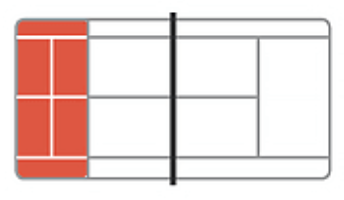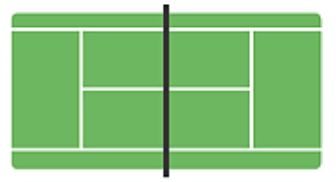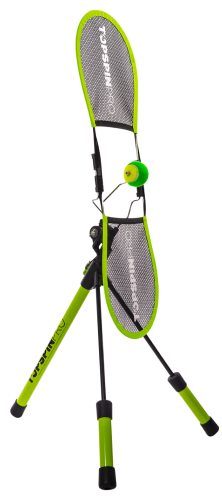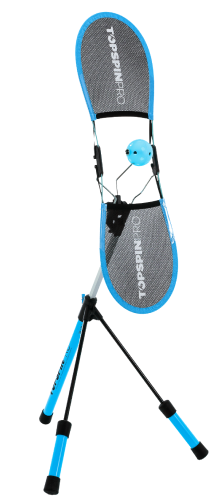When children first start tennis, it’s important to remember that a full-size court, racket, and standard yellow balls are designed for adults, not kids. Expecting young players to succeed with adult equipment is a fast track to frustration. That’s where mini tennis comes in.
Mini tennis is a scaled-down version of the game that uses smaller courts, lighter rackets, and specially designed balls to give children the best chance of enjoying success right from the start. Instead of struggling to swing a heavy racket or chase balls that bounce over their heads, children can grasp the basics much faster. This creates early wins, builds confidence, and makes tennis far more enjoyable.
Beyond just fun, mini tennis lays the foundation for proper technique and movement patterns that will carry through as children grow. It ensures that learning feels manageable, rewarding, and age-appropriate at every stage. In our in-depth guide, we’ll break down each mini tennis stage in detail.
What Is Mini Tennis?
Mini tennis is a scaled-down version of the traditional game, designed specifically for children. It uses smaller courts, lighter rackets, and lower-bouncing balls that travel more slowly, making it easier for kids to rally and play real points right from the start. Instead of being overwhelmed by full-size courts and heavy equipment, children learn the basics step by step in an environment that matches their age and ability. This approach builds confidence, keeps lessons fun, and creates a smooth pathway from beginner tennis all the way to full-court play.
Mini tennis follows a clear pathway: Red → Orange → Green, before moving on to the standard yellow ball. Each stage introduces the game at the right speed, bounce, and court size for a child’s age and development. Below is a breakdown of each stage, what equipment is used, and how it helps your child’s progress.
Benefits of Mini Tennis
Mini tennis creates the perfect environment for children to fall in love with the game. By scaling the equipment and courts to their size, kids experience success early, stay motivated, and develop the skills they need for long-term growth in tennis and beyond.
Benefits at a glance:
✅ Skill Development: Improves speed of learning the fundamentals and proper technique.
✅ Physical Development: Helps avoid injury and encourages use of proper biomechanics to protect body.
✅ Tactical Development: Playing on smaller courts encourages children to think tactically, using angles, placement, and decision-making skills that mirror the strategies of full-size tennis.
✅ Enjoyment: Mini tennis gives children the chance to succeed right away, turning early challenges into fun achievements that help them fall in love with the game.
✅ Pathway to Full Tennis: Smooth progression from red → orange → green balls ensures steady development.
🔴 Red Stage (Ages 4–6)
The red stage is the first main stage of mini tennis. Some players do start before this is they are especially gifted or often to work on coordination type exercises in mini tennis tots classes.
Balls: Large foam or red felt balls, 75% slower than a yellow ball. They bounce lower and move slower, giving children plenty of time to react. The low bounce is crucial here as it stops the players from having to hit the ball above head height.
Court Size: 36 feet long × 18 feet wide — roughly the size of a badminton court.
Net Height: 2’9” (slightly lower than a standard net).
Racket Size: 19–23 inches, lightweight and easy to swing.
Why it works: Red stage is all about introducing the game in the most fun and achievable way. Children can rally, play simple scoring games, and learn the feel of swinging a racket without constant errors. This early success builds confidence and gets kids excited about tennis.

🟠 Orange Stage (Ages 7–9)
Balls: Medium-sized orange balls, 50% slower than a yellow ball. They bounce higher and travel further than red balls but are still easier to control.
Court Size: 60 feet long × 21 feet wide — about three-quarters the size of a full court.
Net Height: 3 feet (slightly lower than the standard 3’6”).
Racket Size: 23–25 inches, depending on height and strength.
Why it works: At this stage, children start to feel more like “real” tennis players. The court is bigger, the rallies are longer, and tactics begin to emerge. Orange stage is ideal for introducing proper movement, spacing, and consistency while keeping the game manageable and fun.

🟢 Green Stage (Ages 9–11+)
Balls: Green balls, 25% slower than a standard yellow ball. They look and feel more like “real” tennis balls but bounce slightly lower and slower, making the transition easier.
Court Size: Full-size court (78 feet × 27 feet for singles).
Net Height: Standard 3’ at the center.
Racket Size: 25–27 inches.
Why it works: Green stage is the bridge between mini tennis and full yellow ball tennis. Children learn to adapt to the full court without the frustration of a ball that feels “too fast.” It’s the stage where confidence really locks in, and players begin to explore tactics, serving, and point construction.

Choosing the Right Equipment
Racket
As mentioned above, choosing the right racket size is one of the most important parts of mini tennis and your child’s development as a player. A racket that is too long or too heavy doesn’t just make the game harder, it can actually create long-term problems. Extra weight forces children to compensate by altering their swing shape, often leading to awkward mechanics, poor timing, and habits that are difficult to correct later. In some cases, it can even put unnecessary strain on young joints and muscles, increasing the risk of injury.
A racket that is properly sized allows children to swing freely and naturally. With the right size, they can focus on learning correct technique and things like spacing, contact point, and follow-through without battling against equipment that holds them back. An age and size-appropriate racket helps build confidence, supports healthy movement, and lays the foundation for long-term success in tennis.
Here are the general guidelines for racket sizing. Keep in mind that every child is different, so be sure to consider not only their age but also their height, build, and physical development when choosing the right racket:
Ages 4–6: 19–23 inches.
Ages 7–9: 23-25 inches.
Ages 10+: 25-27 inches.

Balls
Just like the racket, the type of ball your child uses is crucial for both their development and injury prevention. If a ball bounces too high relative to a child’s height, they are forced to adapt in unnatural ways. This often leads to extreme grips, late or awkward contact points, poor spacing, and inefficient swing shapes. Over time, these habits can become ingrained and very difficult to correct. Using the right stage ball, red, orange, or green, keeps the bounce at a comfortable height, allowing children to swing naturally, build proper technique, and progress confidently.
Shoes
Shoes are one piece of equipment that many parents overlook, but they are just as important as rackets and balls when it comes to keeping your child safe on court. Wearing the wrong shoes, such as running trainers or everyday shoes, can seriously increase the risk of injury. Because these shoes are not designed for the side-to-side movement required in tennis, they offer very little lateral support. This can easily lead to rolled ankles, falls, or even more serious injuries like sprains and fractures.
Proper tennis shoes, on the other hand, are specifically designed for the demands of the sport. They provide the right balance of grip, cushioning, and stability, allowing children to move confidently in every direction. Good footwear also encourages correct footwork patterns, helps maintain balance during strokes, and supports overall athletic development. Investing in a well-fitting pair of tennis shoes right from the start not only protects your child from avoidable injuries but also gives them the freedom to enjoy the game and build strong movement habits for the future.
Clothing
Clothing for tennis doesn’t need to be overly specific unless your child is competing in tournaments, where dress codes sometimes apply. For everyday play, the key is simply to choose good-quality sportswear that allows free movement and keeps your child comfortable on court. Clothes should be lightweight, breathable, and non-restrictive so that swings, lunges, and quick changes of direction feel natural.
It’s also important to dress appropriately for the weather. In warm conditions, moisture-wicking fabrics help keep kids cool and dry, while in cooler months, layering with light jackets or leggings ensures they stay warm without feeling weighed down. A hat and sunscreen are must-haves for sunny days, and in colder climates, gloves and thermal base layers can keep them training comfortably outdoors.
Ultimately, the goal is practicality, clothes that let children move freely, regulate body temperature, and make them feel confident and ready to play.
Other Helpful Equipment
Training Aids - Training aids like the TopspinPro can be helpful for at home practice, warm ups and to get extra reps done. Here's some Tennis Drills For Kids that you can do on the TopspinPro.
Targets - Cones and targets for accuracy practice and training in zones.
Portable Courts - Portable nets or throw-down lines to create a court in driveways, backyards, or parks.
Ball hoppers - Hoppers and buckets to save time and keep practice organized.
Ball Machine - If you and you child are serious about practice then investing in a ball machine can be a great way to get some extra practice.
Conclusion
Mini tennis equipment isn’t just about making the game easier for kids, it’s about giving them the best possible environment to succeed and thrive. By scaling down the court, slowing down the ball, and using lighter rackets, children can experience success from day one. They are able to rally, score points, and feel like real tennis players, which is incredibly motivating at a young age. That early sense of achievement not only boosts confidence but also reinforces correct technique and builds healthy movement habits that will stay with them for life.
Most importantly, mini tennis makes the sport fun and enjoyable. When children are smiling, laughing, and eager to come back to the court, they’re far more likely to stick with tennis long term. This creates a foundation not just for sporting success, but also for a lifelong love of being active, learning new skills, and building resilience.
So, if you’re a parent introducing your child to tennis, take the time to understand the equipment pathway and, if possible, invest in the right gear for their stage. The right choices at the start can make all the difference in how much they enjoy the game and how far they progress.
FAQs
-
What is mini tennis and why is it important for children?
Mini tennis is a scaled-down version of traditional tennis designed for children, using smaller courts, lighter rackets, and slower balls. It helps kids enjoy success early, build confidence, and learn correct technique step by step in a fun and age-appropriate environment.
-
What are the different stages of mini tennis and how do they help a child's development?
Mini tennis has three stages—Red (ages 4-6), Orange (ages 7-9), and Green (ages 9-11+)—each with progressively larger courts, faster balls, and longer rackets. This progression matches a child’s age and skill, making the game manageable while developing their coordination, tactics, and confidence.
-
How should I choose the right racket and ball for my child?
The right racket size is crucial; too heavy or long can cause poor technique and injury. Use age-appropriate rackets (19-23″ for ages 4-6, 23-25″ for 7-9, and 25-27″ for 10+). Similarly, use stage-specific balls (red, orange, green) to keep the bounce comfortable and support natural swing and skill development.
-
Why are proper shoes and clothing important for children playing tennis?
Proper tennis shoes provide essential lateral support, grip, and cushioning to prevent injuries from quick side-to-side movements. Clothing should be lightweight, breathable, and weather-appropriate to allow free movement and keep your child comfortable on court.
-
What are the main benefits of mini tennis beyond just learning to play?
Mini tennis builds life skills like coordination, problem-solving, and teamwork while keeping kids active and social. It makes tennis fun and enjoyable, encouraging long-term participation and a lifelong love of the sport and physical activity.
Enjoyed this article?
Be sure to sign up for our newsletter and we'll keep you up to date about new posts



